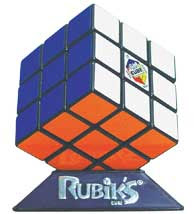 The Rubik's Cube is a mechanical puzzle invented in 1974 by Hungarian sculptor and professor of architecture Ernő Rubik. Originally called the "Magic Cube" by its inventor, Ernő Rubik, this puzzle was renamed "Rubik's Cube" by Ideal Toys in 1980 and won the German Game of the Year special award for Best Puzzle that year. It is said to be the world's best-selling toy, with over 300,000,000 Rubik's Cubes being sold worldwide to date.
The Rubik's Cube is a mechanical puzzle invented in 1974 by Hungarian sculptor and professor of architecture Ernő Rubik. Originally called the "Magic Cube" by its inventor, Ernő Rubik, this puzzle was renamed "Rubik's Cube" by Ideal Toys in 1980 and won the German Game of the Year special award for Best Puzzle that year. It is said to be the world's best-selling toy, with over 300,000,000 Rubik's Cubes being sold worldwide to date.In a classic Rubik's Cube, each of the six faces is covered by 9 stickers, among six solid colours (traditionally being white, yellow, orange, red, blue, and green). A pivot mechanism enables each face to turn independently, thus mixing up the colours. For the puzzle to be solved, each face must be a solid colour.
The Cube celebrated its twenty-fifth anniversary in 2005, when a special edition was released, featuring a sticker in the centre of the reflective face (which replaced the white face) with a "Rubik's Cube 1980-2005" logo, and different packaging.
There exist four widely available variations of the Cube: the 2×2×2 (Pocket Cube, also Mini Cube, Junior Cube, or Ice Cube), the standard 3×3×3 cube, the 4×4×4 (Rubik's Revenge, or Master Cube), and the 5×5×5 (Professor's Cube). Recently, larger sizes are also on the market (V-Cube 6 and V-Cube 7).
For readability, 3x3x3 is frequently abbreviated 3×3 (and similarly for the other sizes) when there is no ambiguity. Common misspellings include "Rubix cube", "Rubics cube", "Rubick's cube", and "Rubiks cube".
The Cube has inspired an entire category of similar puzzles, commonly referred to as twisty puzzles, which includes the cubes of different sizes mentioned above, as well as various other geometric shapes such as the tetrahedron (e. g., the Pyraminx), the octahedron (e. g., the Skewb Diamond), the dodecahedron (e. g., the Megaminx), and the icosahedron (e. g., the Dogic). There are even higher-dimensional virtual puzzles, simulated by computer software that lets the user manipulate objects such as a 4-dimensional Rubik's cube, which cannot be physically built.
 Wanna buy an original rubik's cube? If, yes Click Here.
Wanna buy an original rubik's cube? If, yes Click Here.

Tidak ada komentar:
Posting Komentar